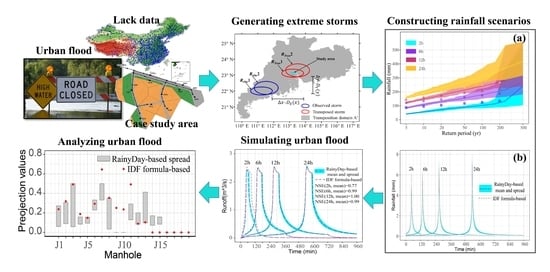Urban Flood Analysis in Ungauged Drainage Basin Using Short-Term and High-Resolution Remotely Sensed Rainfall Records
Abstract
1. Introduction
2. Methodology
2.1. Stochastic Storm Transposition
2.2. Constructing Different Rainfall Scenarios
2.3. Urban Hydrologic Model
2.4. Projection Pursuit Algorithm
3. Data and Case-Study Area
3.1. Data
3.2. Case-Study Area
4. Results
4.1. Estimating the Design Rainfall
4.2. Simulating the Runoff Process Based on RainyDay-Based Estimates
4.3. Analyzing Flood Characteristics Based on RainyDay-Based Estimates
5. Discussion
6. Conclusions
- Combining RainyDay and short-term remotely sensed rainfall data can lengthen the rainfall record through transposing the spatial location of observed rainfall events. It is able to estimate urban extreme rainfall at different return periods (e.g., range in return period from 5- to 100-yr), despite the short (nine-year) observed rainfall record. According to a comparison of the differences between the RainyDay-based and IDF formula-based (a traditional published source of rainfall frequencies) rainfall estimates, RainyDay-based rainfall estimates are basically acceptable for estimating regional design rainfall, especially for relatively high return periods (20-yr or higher) or long durations (6 h or longer).
- The proposed framework shows a good performance for runoff process simulation at the outlet based on RainyDay-based estimates, especially for high return periods or long durations. In the case study, the difference of runoff process between RainyDay-based and IDF formula-based methods is relatively significant at low return periods or for short durations (e.g., NSE = 0.53 at 5-yr return period for 6 h duration), but the difference decreases with the lengthening rainfall duration or increasing return period. The values of NSE are generally above 0.90 at high return periods or long durations.
- Contrasting with the flood-simulated results under different return periods and durations, the flood characteristics of urban flooding at each manhole can be generally revealed based on RainyDay-based estimates at relatively high (20-yr and beyond) return periods or long (6 h or longer) durations. Similar to the results of runoff processes, though RainyDay-based estimates basically underestimate the values of flood indicators (i.e., flood time, maximum rainfall rate, total maximum rainfall volume) or the comprehensive characteristics of urban flooding under low return period or short duration scenarios, these values can be well revealed with increasing duration or return period.
- The proposed modeling framework provides an alternative framework for urban flood analysis in an ungauged drainage basin. This alternative is attractive for the following reasons. First, the proposed framework can produce probabilistic extreme rainfall scenarios based on a very short rainfall record (e.g., nine-year in this study), and it excludes the older rainfall records to eliminate the effect of nonstationarity. Second, the proposed framework provides a way to estimate the ensemble spread of rainfall and flood estimates, rather than a single estimate value; such spread is central to hydrological engineering practices.
Author Contributions
Funding
Institutional Review Board Statement
Informed Consent Statement
Data Availability Statement
Acknowledgments
Conflicts of Interest
References
- Fowler, H.J.; Lenderink, G.; Prein, A.F.; Westra, S.; Allan, R.P.; Ban, N.; Barbero, R.; Berg, P.; Blenkinsop, S.; Do, H.X.; et al. Anthropogenic Intensification of Short-Duration Rainfall Extremes. Nat. Rev. Earth Environ. 2021, 2, 107–122. [Google Scholar] [CrossRef]
- Liu, B.; Tan, X.; Gan, T.Y.; Chen, X.; Lin, K.; Lu, M.; Liu, Z. Global Atmospheric Moisture Transport Associated with Precipitation Extremes: Mechanisms and Climate Change Impacts. WIREs Water 2020, 7, e1412. [Google Scholar] [CrossRef]
- Kemter, M.; Merz, B.; Marwan, N.; Vorogushyn, S.; Blöschl, G. Joint Trends in Flood Magnitudes and Spatial Extents Across Europe. Geophys. Res. Lett. 2020, 46, e2020GL087464. [Google Scholar] [CrossRef]
- Wu, Z.; Zhou, Y.; Wang, H.; Jiang, Z. Depth Prediction of Urban Flood under Different Rainfall Return Periods Based on Deep Learning and Data Warehouse. Sci. Total Environ. 2020, 716, 137077. [Google Scholar] [CrossRef]
- World Resources Institute RELEASE. New Data Shows Millions of People, Trillions in Property at Risk from Flooding—But Infrastructure Investments Now Can Significantly Lower Flood Risk. Available online: https://www.wri.org/news/2020/04/release-new-data-shows-millions-people-trillions-property-risk-flooding-infrastructure (accessed on 13 April 2021).
- Du, S.; Scussolini, P.; Ward, P.J.; Zhang, M.; Wen, J.; Wang, L.; Koks, E.; Diaz-Loaiza, A.; Gao, J.; Ke, Q.; et al. Hard or Soft Flood Adaptation? Advantages of a Hybrid Strategy for Shanghai. Glob. Environ. Chang. 2020, 61, 102037. [Google Scholar] [CrossRef]
- Santos, P.P.; Pereira, S.; Zêzere, J.L.; Tavares, A.O.; Reis, E.; Garcia, R.A.C.; Oliveira, S.C. A Comprehensive Approach to Understanding Flood Risk Drivers at the Municipal Level. J. Environ. Manag. 2020, 260, 110127. [Google Scholar] [CrossRef] [PubMed]
- Chen, J.; Wang, Z.; Wu, X.; Lai, C.; Chen, X. Evaluation of TMPA 3B42-V7 Product on Extreme Precipitation Estimates. Remote Sens. 2021, 13, 209. [Google Scholar] [CrossRef]
- Najibi, N.; Devineni, N. Recent Trends in the Frequency and Duration of Global Floods. Earth Syst. Dyn. 2018, 9, 757–783. [Google Scholar] [CrossRef]
- Zhou, Z.; Smith, J.A.; Yang, L.; Baeck, M.L.; Chaney, M.; Ten Veldhuis, M.-C.; Deng, H.; Liu, S. The Complexities of Urban Flood Response: Flood Frequency Analyses for the Charlotte Metropolitan Region: The complexities of urban flood response. Water Resour. Res. 2017, 53, 7401–7425. [Google Scholar] [CrossRef]
- Zhu, Z.; Wright, D.B.; Yu, G. The Impact of Rainfall Space-Time Structure in Flood Frequency Analysis. Water Resour. Res. 2018, 54, 8983–8998. [Google Scholar] [CrossRef]
- Yu, G.; Wright, D.B.; Holman, K.D. Connecting Hydrometeorological Processes to Low-Probability Floods in the Mountainous Colorado Front Range. Water Resour. Res. 2021, 57, e2021WR029768. [Google Scholar] [CrossRef]
- Sun, Y.; Wendi, D.; Kim, D.E.; Liong, S.-Y. Deriving Intensity–Duration–Frequency (IDF) Curves Using Downscaled in Situ Rainfall Assimilated with Remote Sensing Data. Geosci. Lett. 2019, 6, 17. [Google Scholar] [CrossRef]
- Dai, Q.; Bray, M.; Zhuo, L.; Islam, T.; Han, D. A Scheme for Rain Gauge Network Design Based on Remotely Sensed Rainfall Measurements. J. Hydrometeorol. 2017, 18, 363–379. [Google Scholar] [CrossRef]
- Yu, G.; Wright, D.B.; Zhu, Z.; Smith, C.; Holman, K.D. Process-Based Flood Frequency Analysis in an Agricultural Watershed Exhibiting Nonstationary Flood Seasonality. Hydrol. Earth Syst. Sci. 2019, 23, 2225–2243. [Google Scholar] [CrossRef]
- Li, W.; Lin, K.; Zhao, T.; Lan, T.; Chen, X.; Du, H.; Chen, H. Risk Assessment and Sensitivity Analysis of Flash Floods in Ungauged Basins Using Coupled Hydrologic and Hydrodynamic Models. J. Hydrol. 2019, 572, 108–120. [Google Scholar] [CrossRef]
- Kastridis, A.; Kirkenidis, C.; Sapountzis, M. An Integrated Approach of Flash Flood Analysis in Ungauged Mediterranean Watersheds Using Post-Flood Surveys and Unmanned Aerial Vehicles. Hydrol. Process. 2020, 34, 4920–4939. [Google Scholar] [CrossRef]
- Papaioannou, G.; Vasiliades, L.; Loukas, A.; Aronica, G.T. Probabilistic Flood Inundation Mapping at Ungauged Streams Due to Roughness Coefficient Uncertainty in Hydraulic Modelling. Adv. Geosci. 2017, 44, 23–34. [Google Scholar] [CrossRef]
- Ghorbani, M.A.; Ruskeepää, H.; Singh, V.P.; Sivakumar, B. Flood Frequency Analysis Using Mathematica. Turk. J. Eng. Environ. Sci. 2010, 34, 171–188. [Google Scholar] [CrossRef]
- Salman, A.M.; Li, Y. Flood Risk Assessment, Future Trend Modeling, and Risk Communication: A Review of Ongoing Research. Nat. Hazards Rev. 2018, 19, 4018011. [Google Scholar] [CrossRef]
- François, B.; Schlef, K.E.; Wi, S.; Brown, C.M. Design Considerations for Riverine Floods in a Changing Climate—A Review. J. Hydrol. 2019, 574, 557–573. [Google Scholar] [CrossRef]
- Herman, M.R.; Nejadhashemi, A.P.; Abouali, M.; Hernandez-Suarez, J.S.; Daneshvar, F.; Zhang, Z.; Anderson, M.C.; Sadeghi, A.M.; Hain, C.R.; Sharifi, A. Evaluating the Role of Evapotranspiration Remote Sensing Data in Improving Hydrological Modeling Predictability. J. Hydrol. 2018, 556, 39–49. [Google Scholar] [CrossRef]
- Nguyen, H.D.; Fox, D.; Dang, D.K.; Pham, L.T.; Viet Du, Q.V.; Nguyen, T.H.T.; Dang, T.N.; Tran, V.T.; Vu, P.L.; Nguyen, Q.-H.; et al. Predicting Future Urban Flood Risk Using Land Change and Hydraulic Modeling in a River Watershed in the Central Province of Vietnam. Remote Sens. 2021, 13, 262. [Google Scholar] [CrossRef]
- Mohanty, M.P.; Sherly, M.A.; Karmakar, S.; Ghosh, S. Regionalized Design Rainfall Estimation: An Appraisal of Inundation Mapping for Flood Management Under Data-Scarce Situations. Water Resour. Manag. 2018, 32, 4725–4746. [Google Scholar] [CrossRef]
- Razavi, S.; Tolson, B.A. An Efficient Framework for Hydrologic Model Calibration on Long Data Periods. Water Resour. Res. 2013, 49, 8418–8431. [Google Scholar] [CrossRef]
- Peleg, N.; Fatichi, S.; Paschalis, A.; Molnar, P.; Burlando, P. An Advanced Stochastic Weather Generator for Simulating 2-D High-Resolution Climate Variables: AWE-GEN-2d. J. Adv. Model. Earth Syst. 2017, 9, 1595–1627. [Google Scholar] [CrossRef]
- Wright, D.B.; Mantilla, R.; Peters-Lidard, C.D. A Remote Sensing-Based Tool for Assessing Rainfall-Driven Hazards. Environ. Model. Softw. 2017, 90, 34–54. [Google Scholar] [CrossRef] [PubMed]
- Diaz-Nieto, J.; Wilby, R.L. A comparison of statistical downscaling and climate change factor methods: Impacts on low flows in the river Thames, United Kingdom. Clim. Change 2005, 69, 245–268. [Google Scholar] [CrossRef]
- Cha, S.M.; Lee, S.W. Advanced Hydrological Streamflow Simulation in a Watershed Using Adjusted Radar-Rainfall Estimates as Meteorological Input Data. J. Environ. Manag. 2021, 277, 111393. [Google Scholar] [CrossRef]
- Alahacoon, N.; Matheswaran, K.; Pani, P.; Amarnath, G. A Decadal Historical Satellite Data and Rainfall Trend Analysis (2001–2016) for Flood Hazard Mapping in Sri Lanka. Remote Sens. 2018, 10, 448. [Google Scholar] [CrossRef]
- Notti, D.; Giordan, D.; Caló, F.; Pepe, A.; Zucca, F.; Galve, J.P. Potential and Limitations of Open Satellite Data for Flood Mapping. Remote Sens. 2018, 10, 1673. [Google Scholar] [CrossRef]
- Teng, J.; Jakeman, A.J.; Vaze, J.; Croke, B.F.W.; Dutta, D.; Kim, S. Flood Inundation Modelling: A Review of Methods, Recent Advances and Uncertainty Analysis. Environ. Model. Softw. 2017, 90, 201–216. [Google Scholar] [CrossRef]
- Ding, L.; Ma, L.; Li, L.; Liu, C.; Li, N.; Yang, Z.; Yao, Y.; Lu, H. A Survey of Remote Sensing and Geographic Information System Applications for Flash Floods. Remote Sens. 2021, 13, 1818. [Google Scholar] [CrossRef]
- Getirana, A.; Kirschbaum, D.; Mandarino, F.; Ottoni, M.; Khan, S.; Arsenault, K. Potential of GPM IMERG Precipitation Estimates to Monitor Natural Disaster Triggers in Urban Areas: The Case of Rio de Janeiro, Brazil. Remote Sens. 2020, 12, 4095. [Google Scholar] [CrossRef]
- Li, Y.; Grimaldi, S.; Walker, J.; Pauwels, V. Application of Remote Sensing Data to Constrain Operational Rainfall-Driven Flood Forecasting: A Review. Remote Sens. 2016, 8, 456. [Google Scholar] [CrossRef]
- Shakti, P.C.; Kamimera, H.; Misumi, R. Inundation Analysis of the Oda River Basin in Japan during the Flood Event of 6–7 July 2018 Utilizing Local and Global Hydrographic Data. Water 2020, 12, 1005. [Google Scholar] [CrossRef]
- Komi, K.; Neal, J.; Trigg, M.A.; Diekkrüger, B. Modelling of Flood Hazard Extent in Data Sparse Areas: A Case Study of the Oti River Basin, West Africa. J. Hydrol. Reg. Stud. 2017, 10, 122–132. [Google Scholar] [CrossRef]
- Wright, D.B. Estimating the Frequency of Extreme Rainfall Using Weather Radar and Stochastic Storm Transposition. J. Hydrol. 2013, 488, 150–165. [Google Scholar] [CrossRef]
- D’Oria, M.; Maranzoni, A.; Mazzoleni, M. Probabilistic Assessment of Flood Hazard Due to Levee Breaches Using Fragility Functions. Water Resour. Res. 2019, 55, 8740–8764. [Google Scholar] [CrossRef]
- Zhu, Z.; Chen, Z.; Chen, X.; He, P. Approach for Evaluating Inundation Risks in Urban Drainage Systems. Sci. Total Environ. 2016, 553, 1–12. [Google Scholar] [CrossRef]
- Yang, W.; Xu, K.; Lian, J.; Bin, L.; Ma, C. Multiple Flood Vulnerability Assessment Approach Based on Fuzzy Comprehensive Evaluation Method and Coordinated Development Degree Model. J. Environ. Manag. 2018, 213, 440–450. [Google Scholar] [CrossRef]
- Nandi, A.; Mandal, A.; Wilson, M.; Smith, D. Flood Hazard Mapping in Jamaica Using Principal Component Analysis and Logistic Regression. Environ. Earth Sci. 2016, 75, 465. [Google Scholar] [CrossRef]
- Sarmah, T.; Das, S.; Narendr, A.; Aithal, B.H. Assessing Human Vulnerability to Urban Flood Hazard Using the Analytic Hierarchy Process and Geographic Information System. Int. J. Disaster Risk Reduct. 2020, 50, 101659. [Google Scholar] [CrossRef]
- Liang, L.; Deng, X.; Wang, P.; Wang, Z.; Wang, L. Assessment of the Impact of Climate Change on Cities Livability in China. Sci. Total Environ. 2020, 726, 138339. [Google Scholar] [CrossRef]
- Wu, Z.; Lv, H.; Meng, Y.; Guan, X.; Zang, Y. The Determination of Flood Damage Curve in Areas Lacking Disaster Data Based on the Optimization Principle of Variation Coefficient and Beta Distribution. Sci. Total Environ. 2021, 750, 142277. [Google Scholar] [CrossRef]
- The Ministry of Water Resources of the People’s Republic of China Bulletin on China Flood and Drought Disasters [EB/OL]. 2016. Available online: http://Www.Mwr.Gov.Cn (accessed on 7 August 2017).
- Yu, G.; Wright, D.B.; Li, Z. The Upper Tail of Precipitation in Convection-Permitting Regional Climate Models and Their Utility in Nonstationary Rainfall and Flood Frequency Analysis. Earths Future 2020, 8, e2020EF001613. [Google Scholar] [CrossRef]
- Franchini, M.; Helmlinger, K.R.; Foufoula-Georgiou, E.; Todini, E. Stochastic Storm Transposition Coupled with Rainfall—Runoff Modeling for Estimation of Exceedance Probabilities of Design Floods. J. Hydrol. 1996, 175, 511–532. [Google Scholar] [CrossRef]
- Wilson, L.L.; Foufoula-Georgiou, E. Regional Rainfall Frequency Analysis via Stochastic Storm Transposition. J. Hydraul. Eng. 1990, 116, 859–880. [Google Scholar] [CrossRef]
- Chen, W.; Huang, G.; Zhang, H.; Wang, W. Urban Inundation Response to Rainstorm Patterns with a Coupled Hydrodynamic Model: A Case Study in Haidian Island, China. J. Hydrol. 2018, 1022–1035. [Google Scholar] [CrossRef]
- Deng, J.; Yin, H.; Kong, F.; Chen, J.; Dronova, I.; Pu, Y. Determination of Runoff Response to Variation in Overland Flow Area by Flow Routes Using UAV Imagery. J. Environ. Manag. 2020, 265, 109868. [Google Scholar] [CrossRef] [PubMed]
- Shojaeizadeh, A.; Geza, M.; Hogue, T.S. GIP-SWMM: A New Green Infrastructure Placement Tool Coupled with SWMM. J. Environ. Manag. 2021, 277, 111409. [Google Scholar] [CrossRef] [PubMed]
- Gironás, J.; Roesner, L.A.; Rossman, L.A.; Davis, J. A New Applications Manual for the Storm Water Management Model (SWMM). Environ. Model. Softw. 2010, 25, 813–814. [Google Scholar] [CrossRef]
- Zhu, Z.; Chen, Z.; Chen, X.; Yu, G. An Assessment of the Hydrologic Effectiveness of Low Impact Development (LID) Practices for Managing Runoff with Different Objectives. J. Environ. Manag. 2019, 231, 504–514. [Google Scholar] [CrossRef]
- Zhi, G.; Liao, Z.; Tian, W.; Wu, J. Urban Flood Risk Assessment and Analysis with a 3D Visualization Method Coupling the PP-PSO Algorithm and Building Data. J. Environ. Manag. 2020, 268, 110521. [Google Scholar] [CrossRef] [PubMed]
- Guo, Q.; Wang, J.; Yin, H.; Zhang, G. A Comprehensive Evaluation Model of Regional Atmospheric Environment Carrying Capacity_ Model Development and a Case Study in China. Ecol. Indic. 2018, 259–267. [Google Scholar] [CrossRef]
- Kruskal, J.; Shepard, R. A Nonmetric Variety of Linear Factor Analysis. Psychometrika 1974, 39, 123–157. [Google Scholar] [CrossRef]
- Kennedy, J.; Eberhart, R. Particle swarm optimization. In Proceedings of the IEEE International Conference on Neural Networks—Conference Proceedings, Perth, WA, Australia, 27 November–1 December 1995; pp. 1942–1948. [Google Scholar]
- Shen, Y.; Zhao, P.; Pan, Y.; Yu, J. A High Spatiotemporal Gauge-Satellite Merged Precipitation Analysis over China. J. Geophys. Res. Atmos. 2014, 119, 3063–3075. [Google Scholar] [CrossRef]
- Wang, D.; Wang, X.; Liu, L.; Wang, D.; Huang, H.; Pan, C. Evaluation of TMPA 3B42V7, GPM IMERG and CMPA Precipitation Estimates in Guangdong Province, China. Int. J. Climatol. 2019, 39, 738–755. [Google Scholar] [CrossRef]
- Yalcin, E. Two-Dimensional Hydrodynamic Modelling for Urban Flood Risk Assessment Using Unmanned Aerial Vehicle Imagery: A Case Study of Kirsehir, Turkey. J. Flood Risk Manag. 2019, 12, e12499. [Google Scholar] [CrossRef]
- Anni, A.H.; Cohen, S.; Praskievicz, S. Sensitivity of Urban Flood Simulations to Stormwater Infrastructure and Soil Infiltration. J. Hydrol. 2020, 588, 125028. [Google Scholar] [CrossRef]
- Ciach, G.J.; Morrissey, M.L.; Krajewski, W.F. Conditional Bias in Radar Rainfall Estimation. J. Appl. Meteorol. Climatol. 2000, 39, 1941–1946. [Google Scholar] [CrossRef]
- Ringard, J.; Becker, M.; Seyler, F.; Linguet, L. Temporal and Spatial Assessment of Four Satellite Rainfall Estimates over French Guiana and North Brazil. Remote Sens. 2015, 7, 16441–16459. [Google Scholar] [CrossRef]
- Tian, Y.; Peters-Lidard, C.D. Systematic Anomalies over Inland Water Bodies in Satellite-Based Precipitation Estimates. Geophys. Res. Lett. 2007, 34, L14403. [Google Scholar] [CrossRef]
- Wright, D.B.; Smith, J.A.; Baeck, M.L. Flood Frequency Analysis Using Radar Rainfall Fields and Stochastic Storm Transposition. Water Resour. Res. 2014, 50, 1592–1615. [Google Scholar] [CrossRef]
- Kim, D.; Onof, C. A Stochastic Rainfall Model That Can Reproduce Important Rainfall Properties across the Timescales from Several Minutes to a Decade. J. Hydrol. 2020, 589, 125150. [Google Scholar] [CrossRef]
- Habib, E.; Henschke, A.; Adler, R.F. Evaluation of TMPA Satellite-Based Research and Real-Time Rainfall Estimates during Six Tropical-Related Heavy Rainfall Events over Louisiana, USA. Atmos. Res. 2009, 94, 373–388. [Google Scholar] [CrossRef]
- Bruni, G.; Reinoso, R.; van de Giesen, N.C.; Clemens, F.H.L.R.; ten Veldhuis, J.A.E. On the Sensitivity of Urban Hydrodynamic Modelling to Rainfall Spatial and Temporal Resolution. Hydrol. Earth Syst. Sci. 2015, 19, 691–709. [Google Scholar] [CrossRef]
- Zhou, Z.; Smith, J.A.; Wright, D.B.; Baeck, M.L.; Yang, L.; Liu, S. Storm Catalog-Based Analysis of Rainfall Heterogeneity and Frequency in a Complex Terrain. Water Resour. Res. 2019, 55, 1871–1889. [Google Scholar] [CrossRef]
- Li, J.; Evans, J.; Johnson, F.; Sharma, A. A Comparison of Methods for Estimating Climate Change Impact on Design Rainfall Using a High-Resolution RCM. J. Hydrol. 2017, 547, 413–427. [Google Scholar] [CrossRef]
- Peleg, N.; Blumensaat, F.; Molnar, P.; Fatichi, S.; Burlando, P. Partitioning the Impacts of Spatial and Climatological Rainfall Variability in Urban Drainage Modeling. Hydrol. Earth Syst. Sci. 2017, 21, 1559–1572. [Google Scholar] [CrossRef]
- Tian, Y.; Peters-Lidard, C.D.; Eylander, J.B.; Joyce, R.J.; Huffman, G.J.; Adler, R.F.; Hsu, K.; Turk, F.J.; Garcia, M.; Zeng, J. Component Analysis of Errors in Satellite-Based Precipitation Estimates. J. Geophys. Res. Atmos. 2009, 114, D24101. [Google Scholar] [CrossRef]
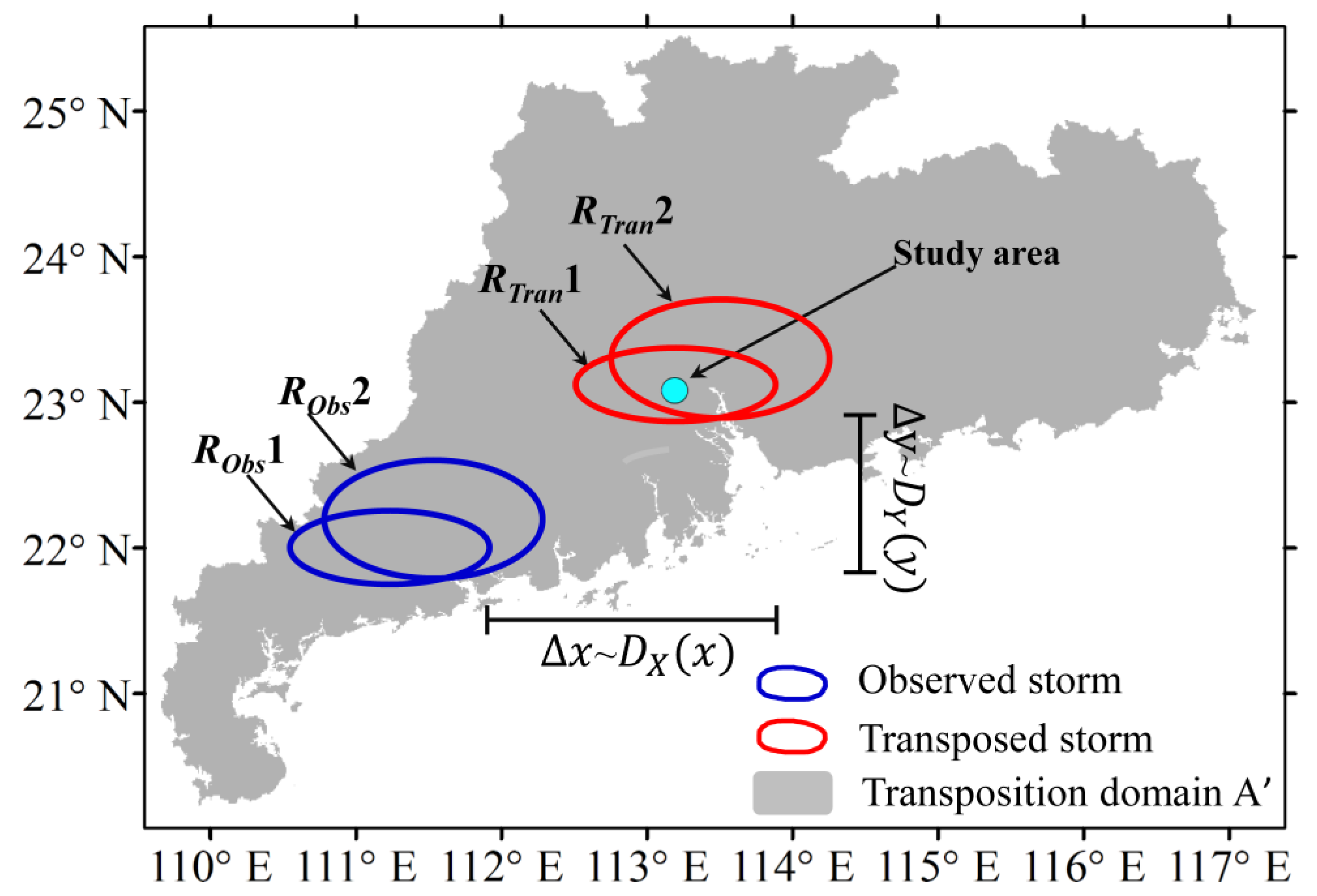

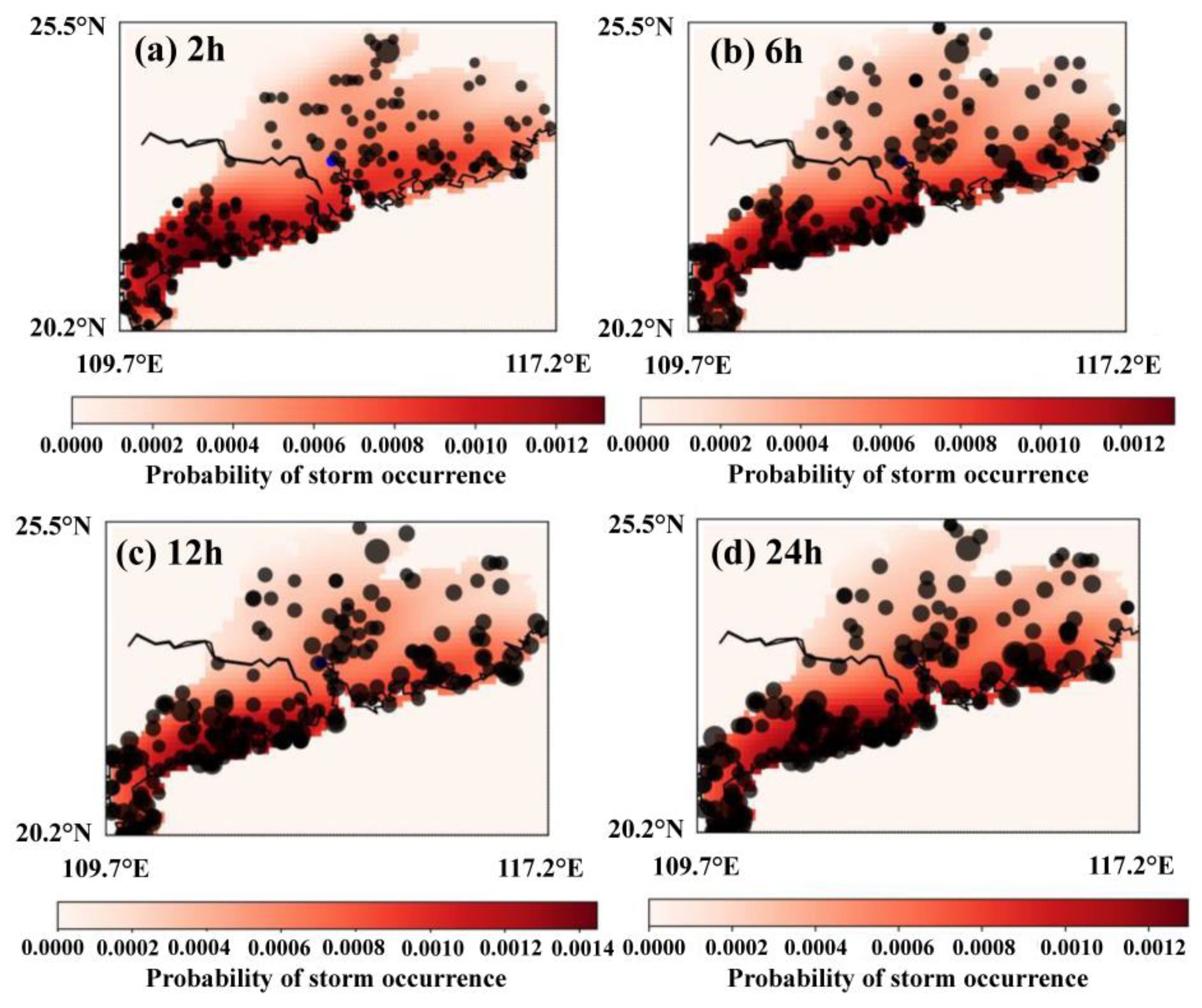
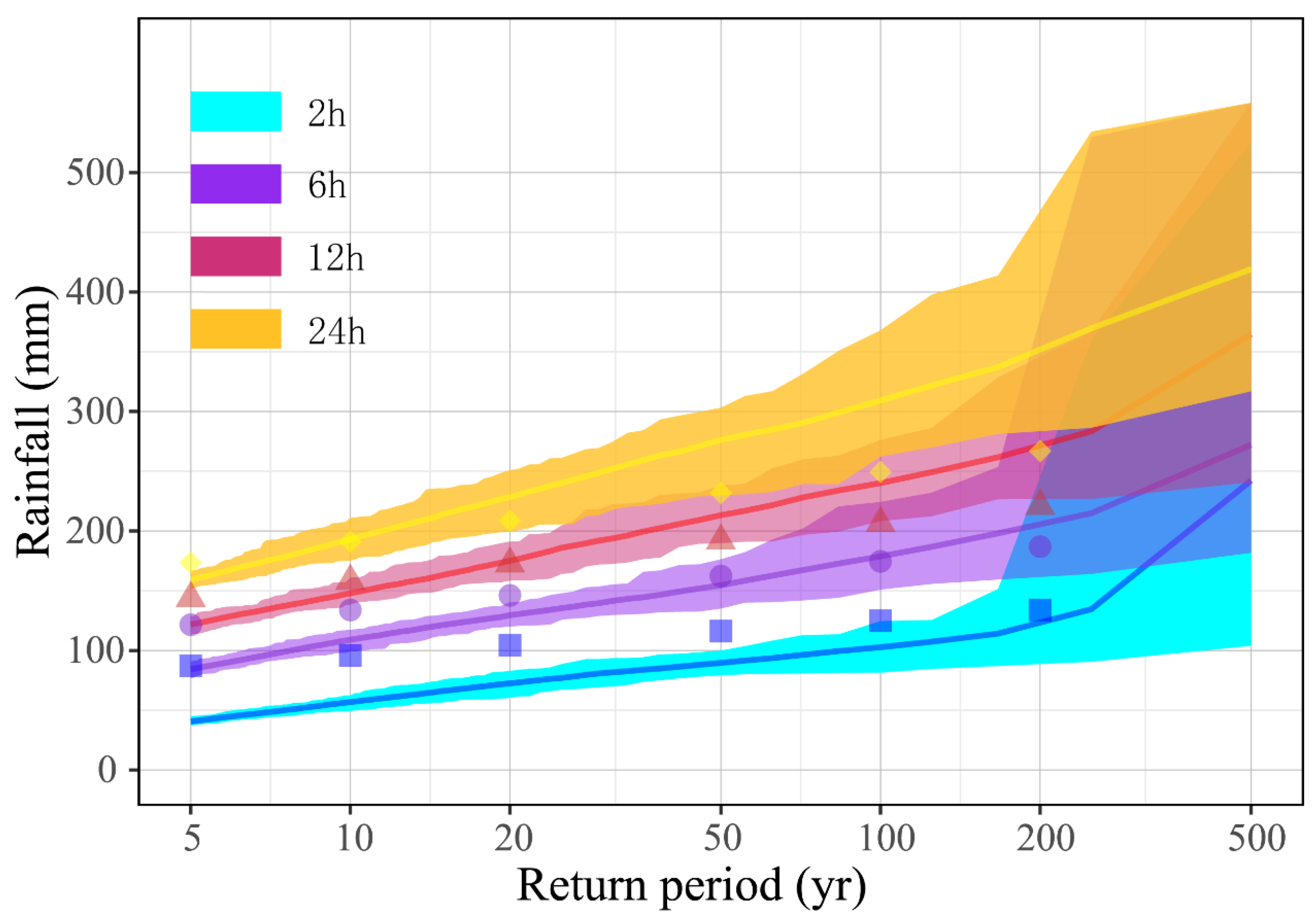
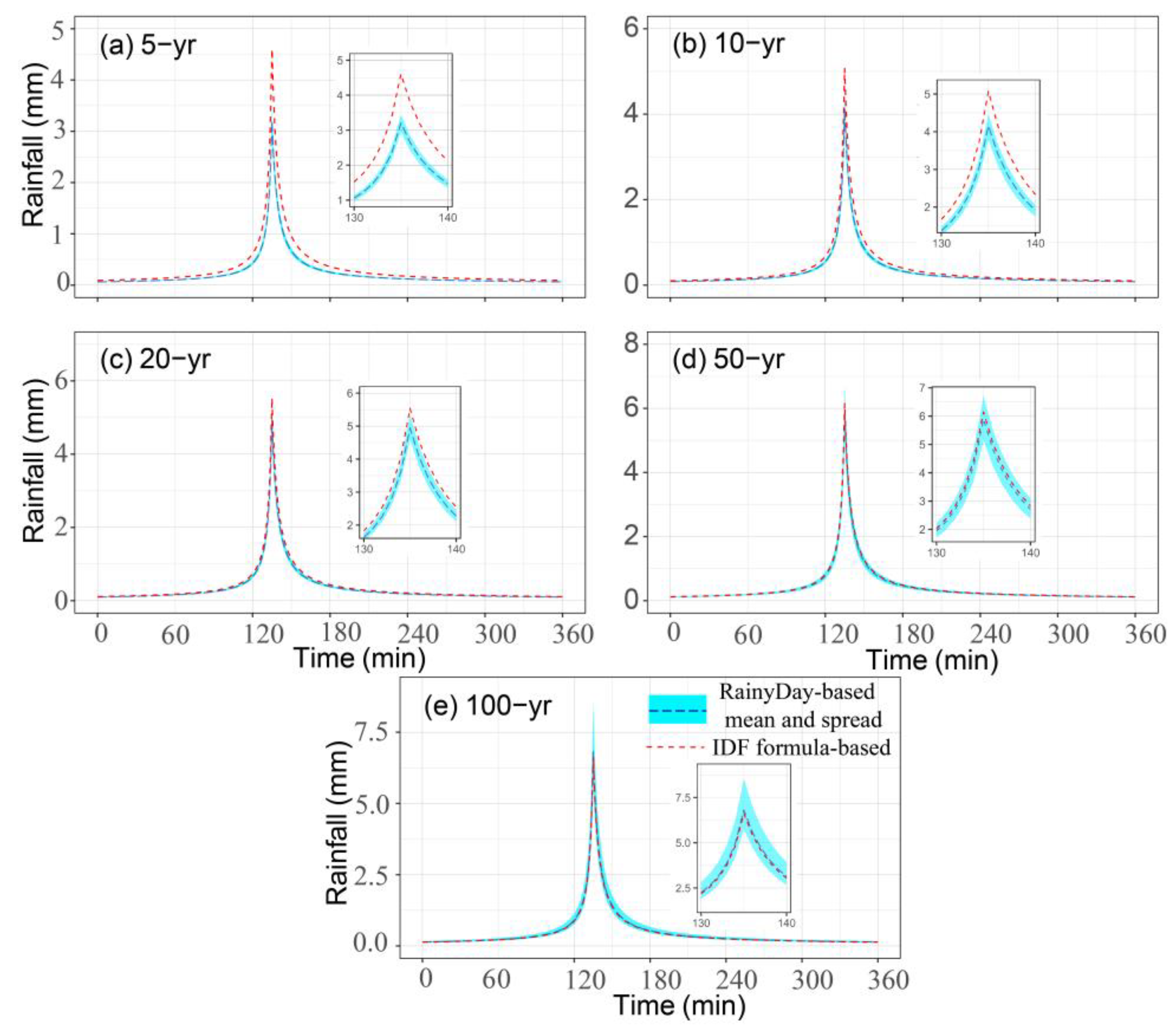
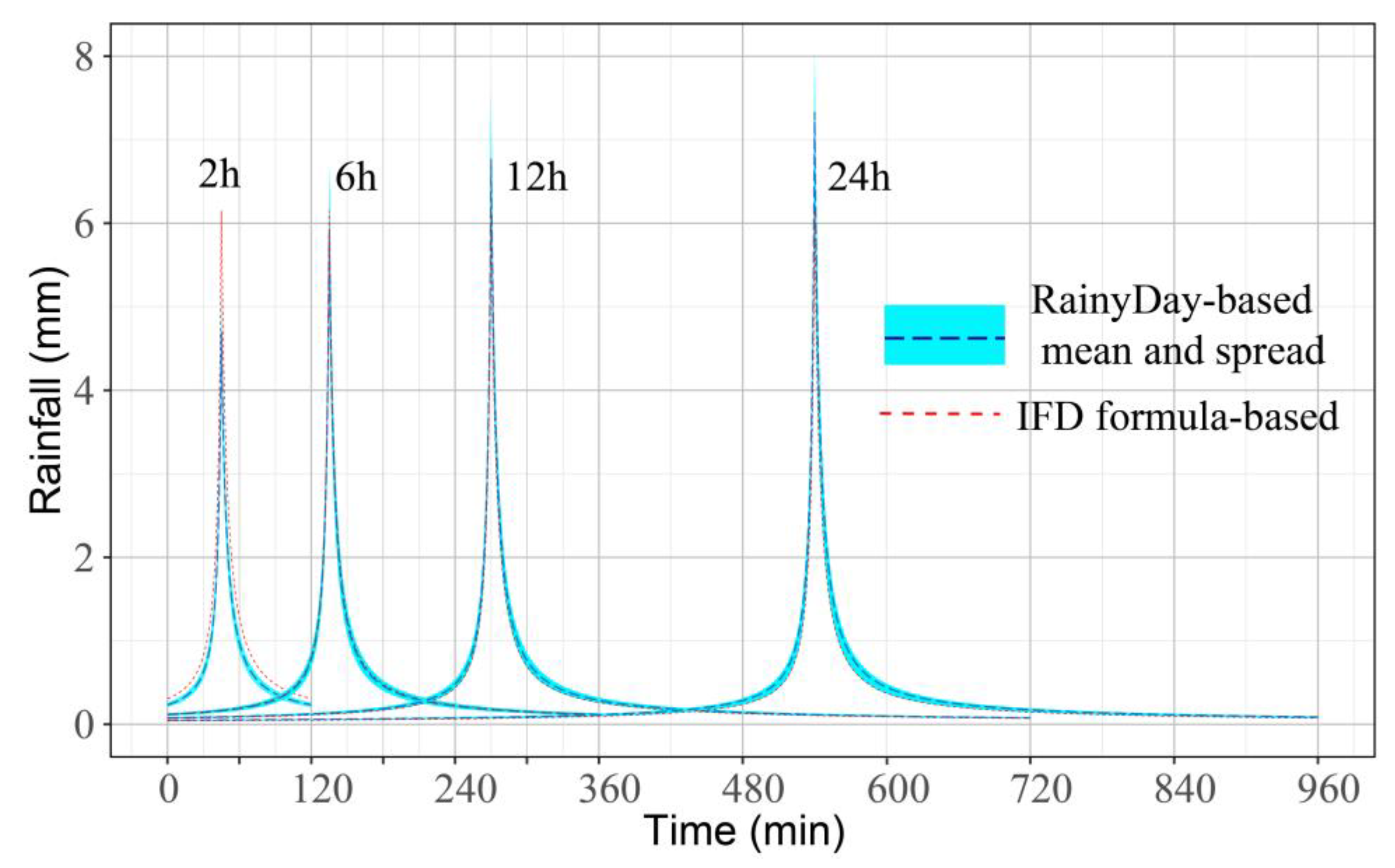
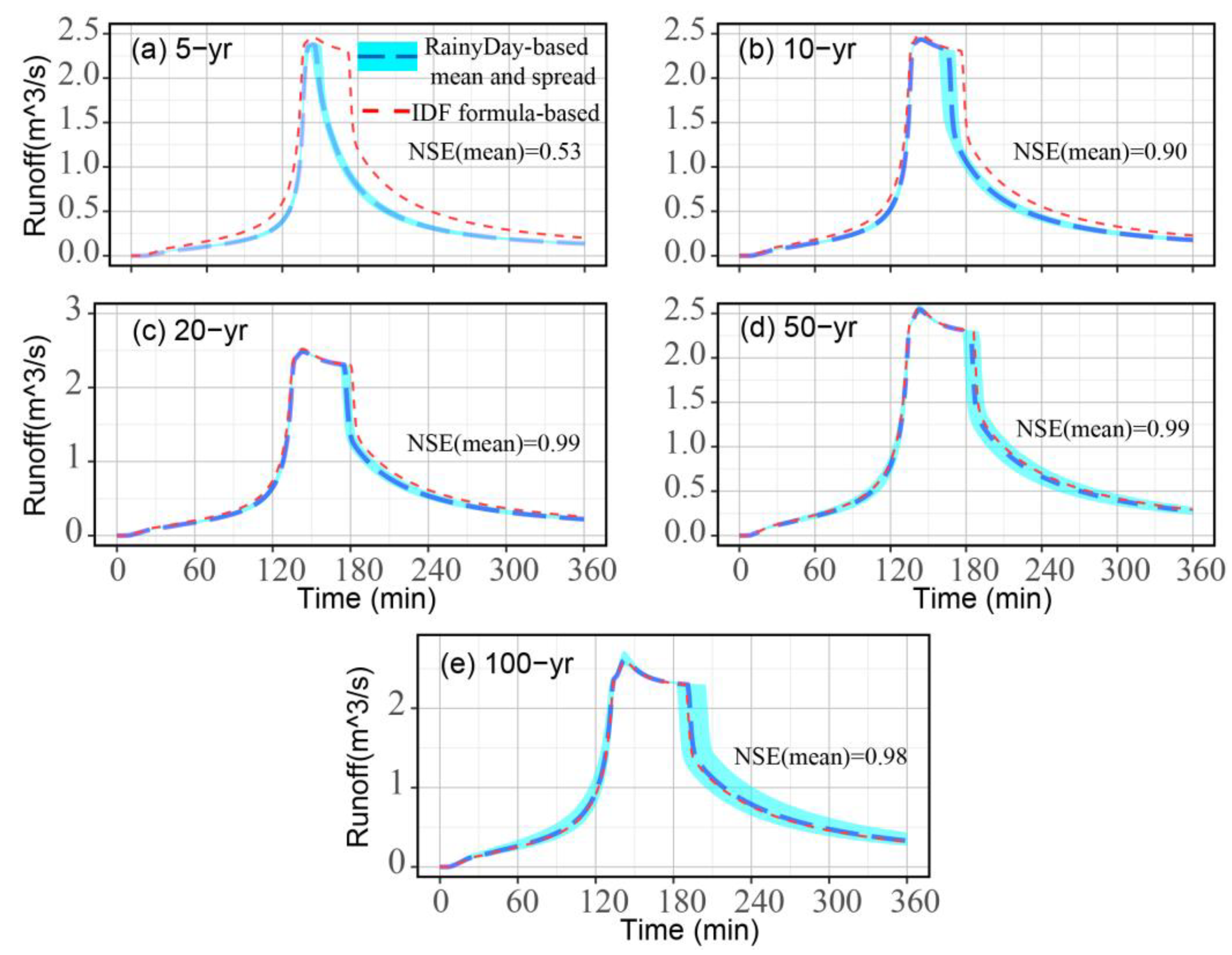
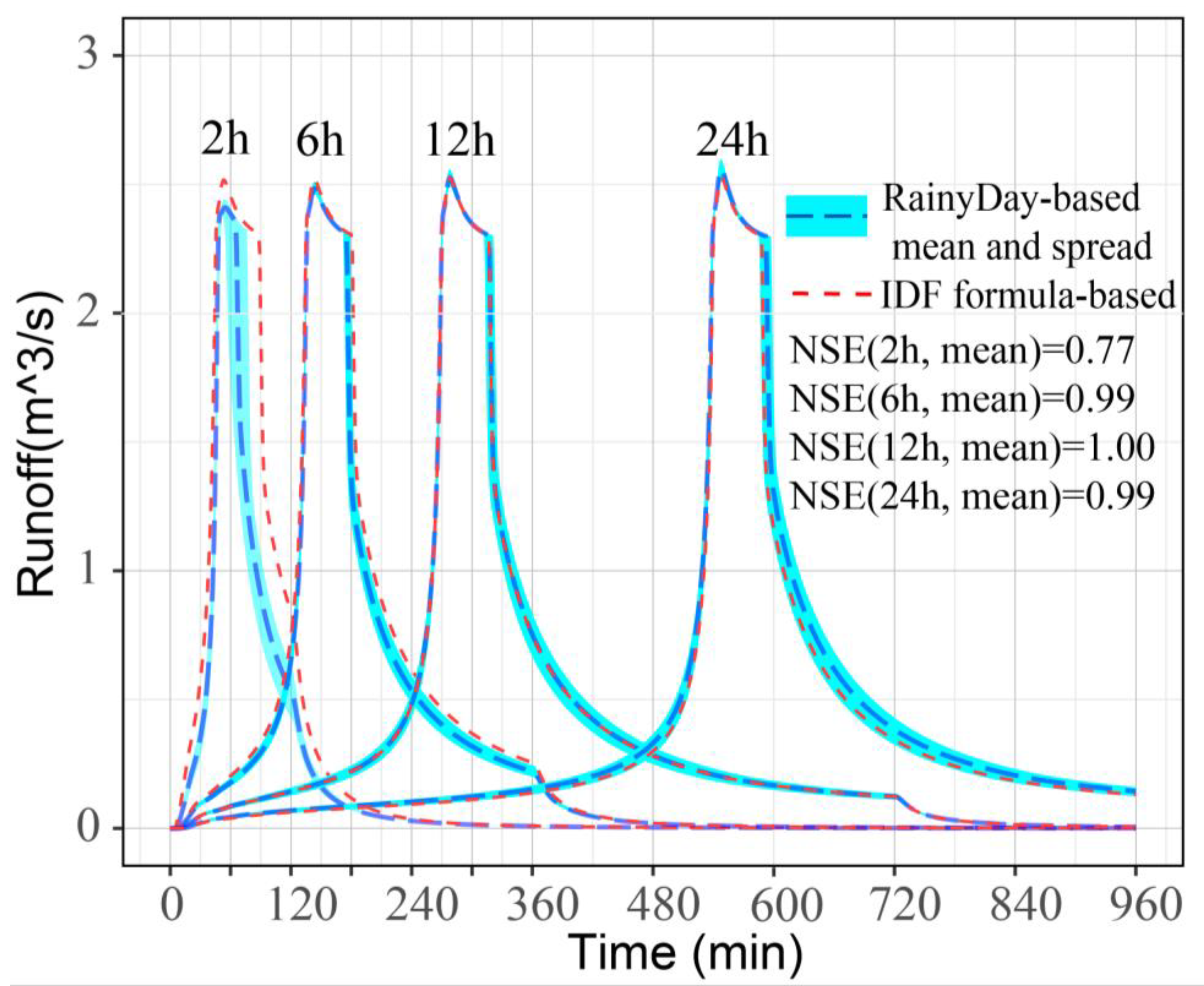
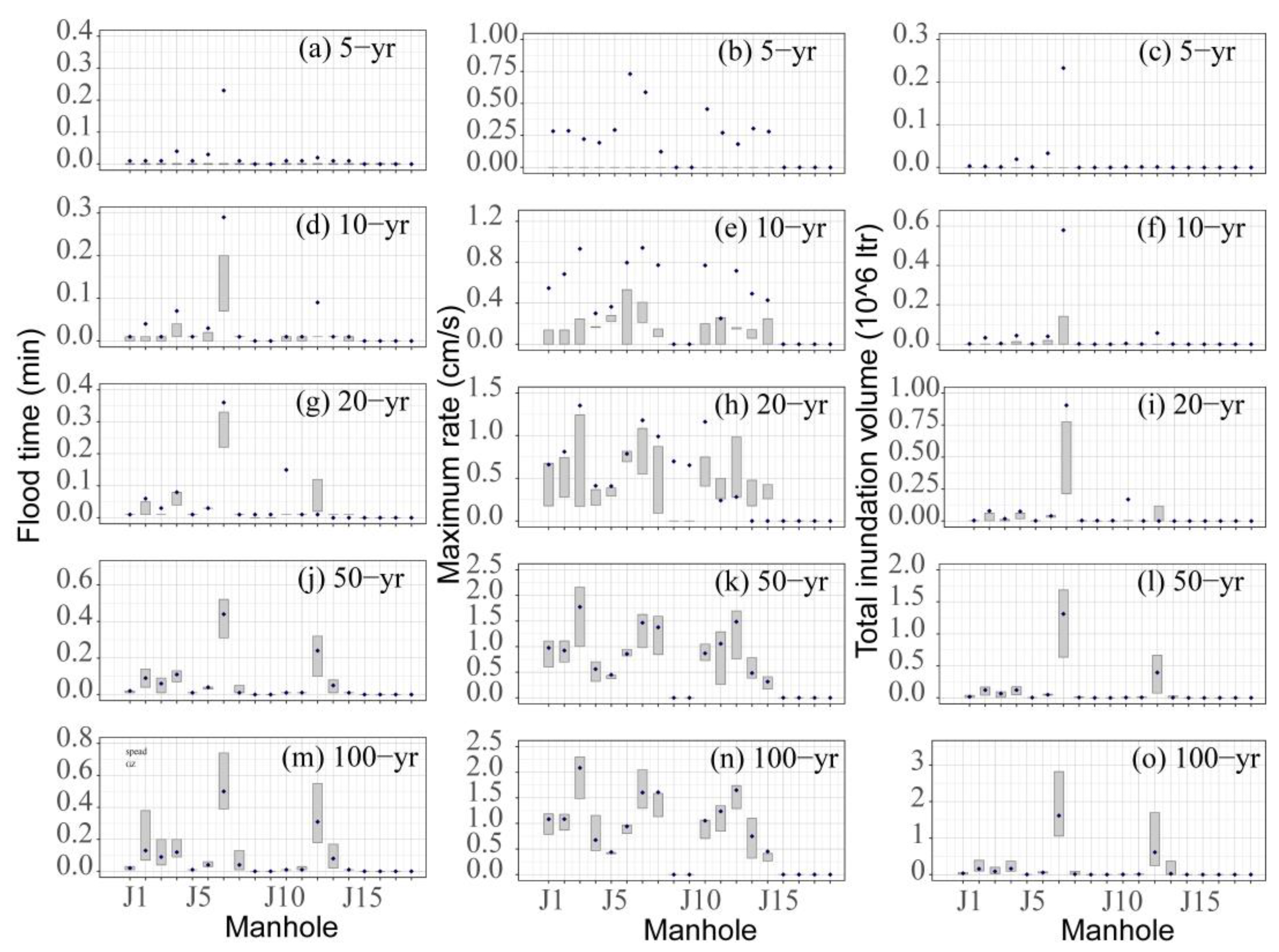
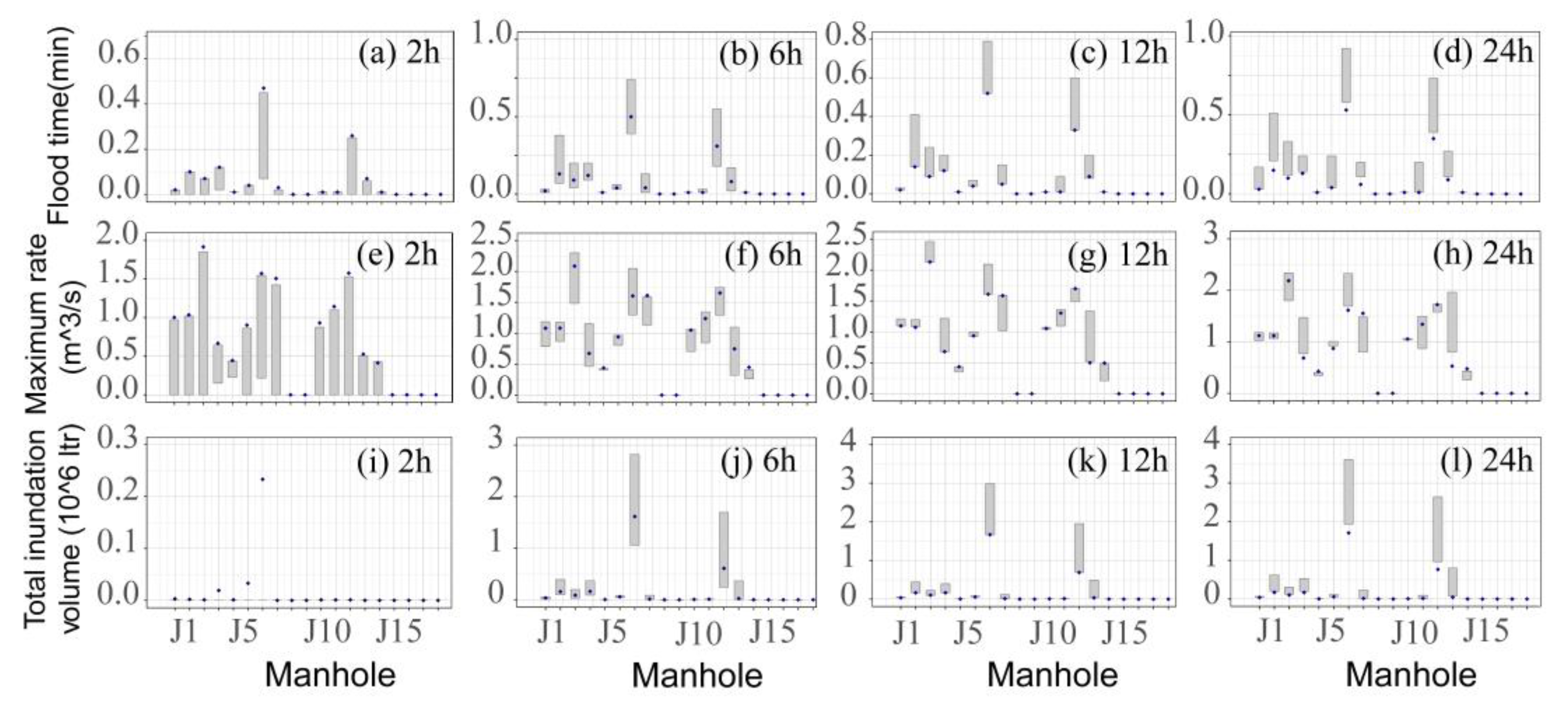
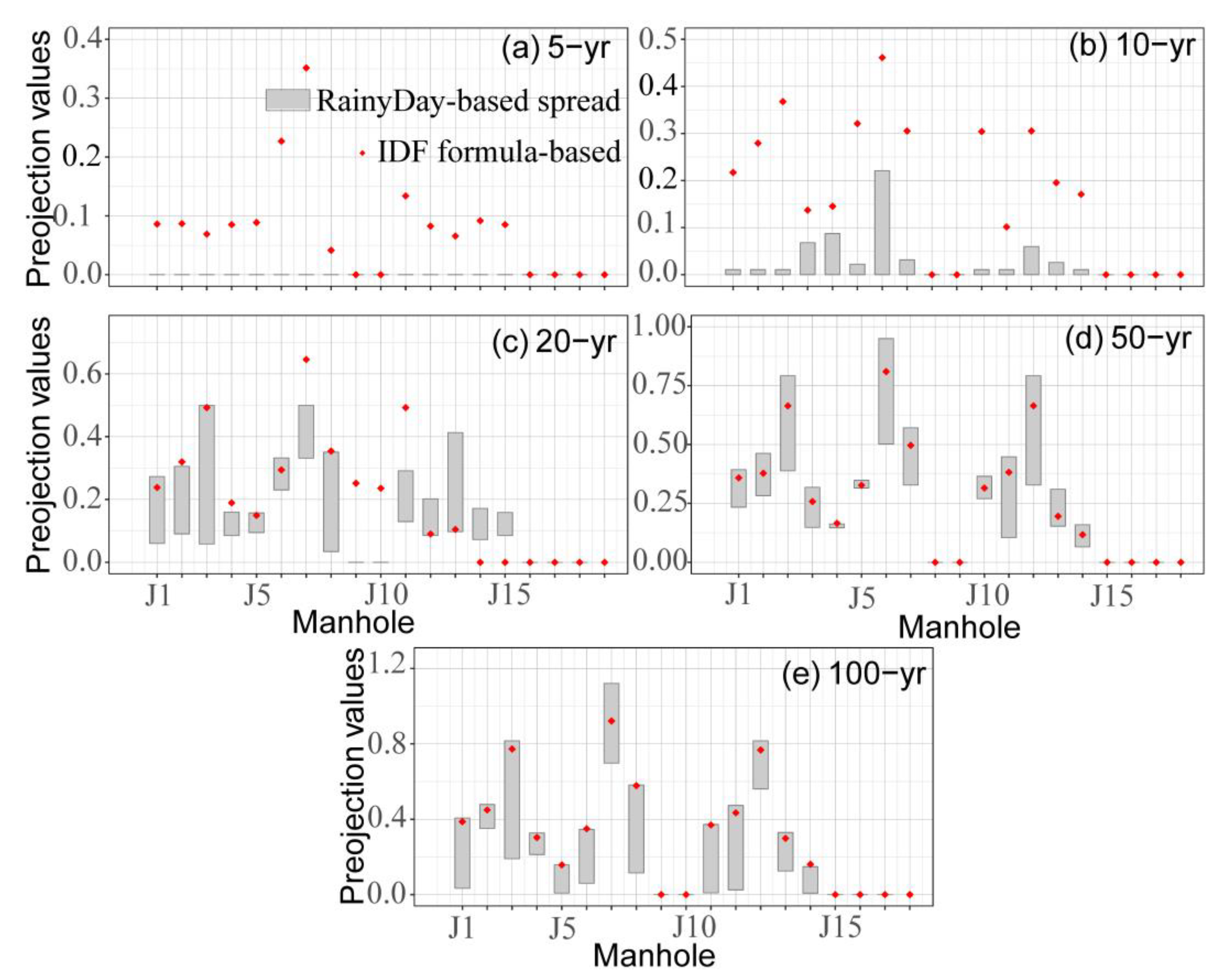
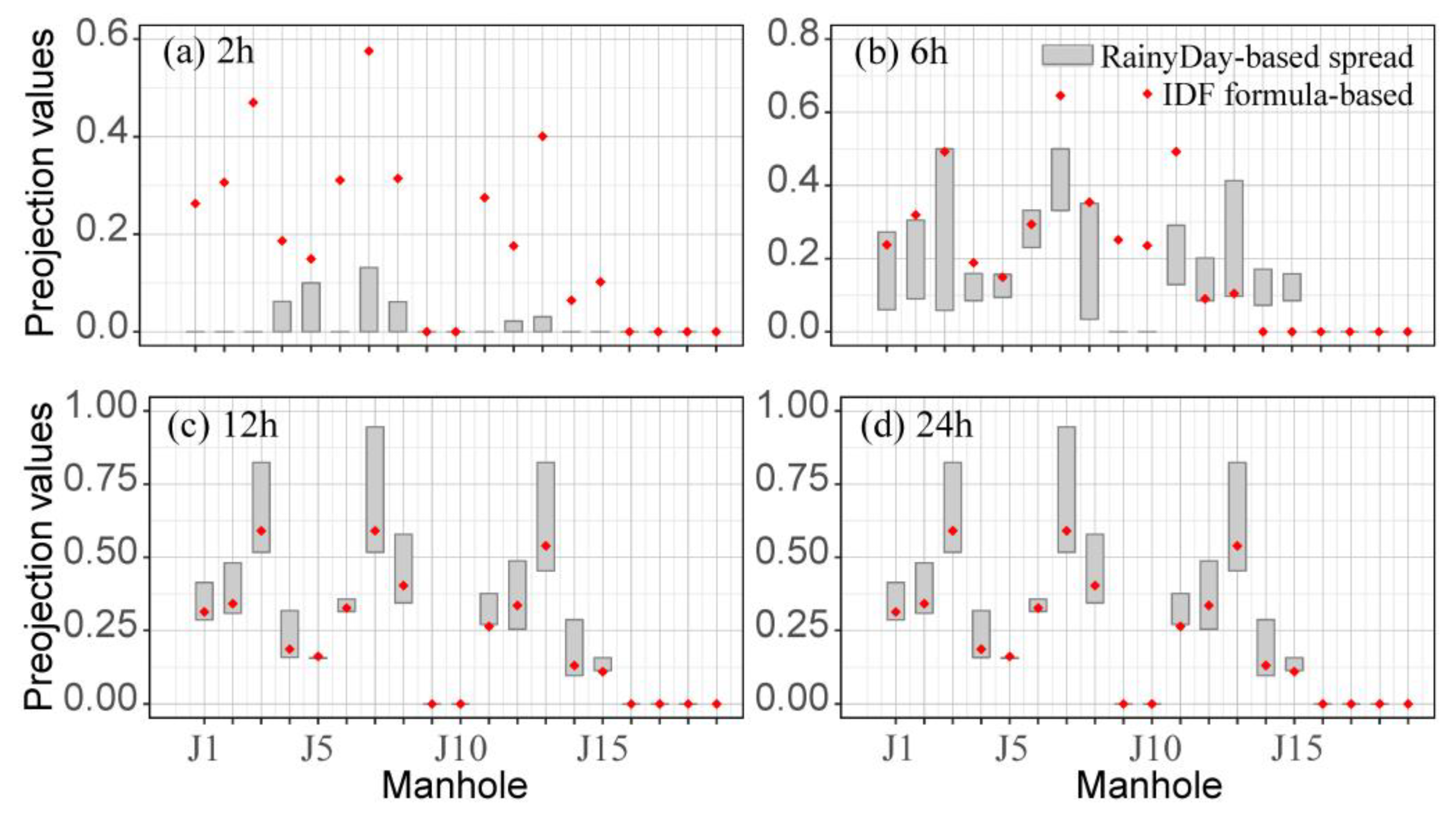
| Return Period | 2 h | 6 h | 12 h | 24 h | ||||||||
|---|---|---|---|---|---|---|---|---|---|---|---|---|
| min | mean | max | min | mean | max | min | mean | max | min | mean | max | |
| 5-yr | −57 | −53.3 | −48.4 | −17.2 | −9.6 | −2.7 | −20.6 | −15.2 | −10.4 | −12.7 | −8.2 | −4.1 |
| 10-yr | −48.7 | −40.7 | −34.9 | −18.3 | −10.3 | −3.4 | −12.5 | −6.5 | 1.7 | −8.3 | 0.9 | 10.4 |
| 20-yr | −42.1 | −30.6 | −20.6 | −17.8 | −11.3 | −4 | −8.2 | 1.5 | 10.8 | −4.5 | 9.5 | 20.2 |
| 50-yr | −31.9 | −22.9 | −14.1 | −16.8 | −4.8 | 8.6 | −1 | 11.2 | 24.1 | −1 | 19.1 | 30.8 |
| 100-yr | −34.8 | −17.8 | −0.4 | −13.6 | 2.4 | 28.5 | 1 | 16.4 | 33.9 | 5.2 | 24 | 47.6 |
Publisher’s Note: MDPI stays neutral with regard to jurisdictional claims in published maps and institutional affiliations. |
© 2021 by the authors. Licensee MDPI, Basel, Switzerland. This article is an open access article distributed under the terms and conditions of the Creative Commons Attribution (CC BY) license (https://creativecommons.org/licenses/by/4.0/).
Share and Cite
Zhu, Z.; Yang, Y.; Cai, Y.; Yang, Z. Urban Flood Analysis in Ungauged Drainage Basin Using Short-Term and High-Resolution Remotely Sensed Rainfall Records. Remote Sens. 2021, 13, 2204. https://doi.org/10.3390/rs13112204
Zhu Z, Yang Y, Cai Y, Yang Z. Urban Flood Analysis in Ungauged Drainage Basin Using Short-Term and High-Resolution Remotely Sensed Rainfall Records. Remote Sensing. 2021; 13(11):2204. https://doi.org/10.3390/rs13112204
Chicago/Turabian StyleZhu, Zhihua, Yueying Yang, Yanpeng Cai, and Zhifeng Yang. 2021. "Urban Flood Analysis in Ungauged Drainage Basin Using Short-Term and High-Resolution Remotely Sensed Rainfall Records" Remote Sensing 13, no. 11: 2204. https://doi.org/10.3390/rs13112204
APA StyleZhu, Z., Yang, Y., Cai, Y., & Yang, Z. (2021). Urban Flood Analysis in Ungauged Drainage Basin Using Short-Term and High-Resolution Remotely Sensed Rainfall Records. Remote Sensing, 13(11), 2204. https://doi.org/10.3390/rs13112204





